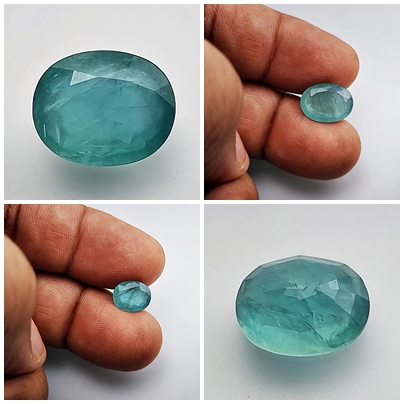
Grandidierite: Gemstone Information
Grandidierite is the One the Most expensive and rare gemstone in the world, and it is one the rarest top 10 gemstone Types in the world, along with gems like jeremejevite, painite, benitoite and taafeite. Grandidierite It forms in the orthorhombic crystal system; it is typically bluish-green in color and distinctive color from traces of iron. Gemmy material is translucent to transparent. Fully transparent specimens are ultra rare.
Grandidierite is the most favourite gemstone for gem collectors and love to add their collection, but it has been almost difficult to find.
The recent discovery of some gem quality material in Madagascar has now made a few high-quality stones available. While trichroism can usually help distinguish grandidierite from other gems, It has strong pleochroism: dark blue-green, colorless and dark green. Grandidierite was first discovered in 1902 in Madagascar by Alfred Lacroix, a French mineralogist. Lacroix named the mineral in honor of French explorer and naturalist Alfred Grandidier (1836–1912), the first authority on the natural history of Madagascar.
Sources:
The type locality and many wells understood location is Andrahomana, southwest of Fort Dauphin, southern Madagascar. Other sources that are minor Kachenbere Hills, Malawi; Béjaia, Algeria; Ontario, Canada; Warren County, NY, USA; Tuscany, Italy; Masataka, Surinam; Cuvier Island, brand new Zealand and Norway.
Grandidierite: Unveiling the Rarity and Benefits of a Prized Gemstone
Introduction:
Grandidierite, an exquisite gemstone named after the French explorer Alfred Grandidier, stands out for its rarity, stunning color, and remarkable properties. With its captivating blue-green hues reminiscent of the ocean depths, grandidierite has captured the fascination of gemstone enthusiasts and collectors worldwide. In this exploration, we’ll delve into the origins, characteristics, and myriad benefits of grandidierite, uncovering its remarkable beauty and value.
Origin and Formation:
Grandidierite was first discovered in Madagascar in 1902 and later named in honor of Alfred Grandidier, a renowned French naturalist and explorer. It is primarily found in metamorphic rocks, particularly in regions with high levels of aluminum and boron. Grandidierite forms through geological processes involving the crystallization of molten magma and subsequent metamorphism under high-pressure and temperature conditions over millions of years. Its unique crystal structure and composition give rise to its distinctive coloration and properties.
Physical Characteristics:
One of the most striking features of grandidierite is its vibrant blue-green color, which ranges from translucent to transparent. This remarkable hue is attributed to the presence of trace elements such as iron and chromium within the crystal lattice. Grandidierite crystals may exhibit a vitreous to pearly luster, adding to their visual appeal and allure. Additionally, grandidierite is prized for its excellent transparency and clarity, allowing light to pass through and enhance its brilliance.
Metaphysical Properties:
Grandidierite is revered for its metaphysical properties and spiritual significance, believed to resonate with the throat and heart chakras, promoting communication, emotional healing, and spiritual growth. In crystal healing practices, grandidierite is associated with qualities such as clarity of expression, compassion, and inner peace. It is said to facilitate honest and open communication, deepen emotional connections, and foster a sense of harmony and understanding. Grandidierite’s gentle energy is thought to soothe the mind, calm the emotions, and promote a sense of serenity and well-being.
Healing Benefits:
Grandidierite is reputed to offer a range of healing benefits for both physical and emotional well-being. It is said to support the respiratory system, aid in detoxification, and promote overall vitality and wellness. Some believe that grandidierite can alleviate symptoms of stress, anxiety, and depression by soothing the nervous system and promoting relaxation. Additionally, grandidierite is thought to facilitate emotional healing, helping individuals release negative emotions and find inner balance and serenity.
Chakra Alignment:
Grandidierite is closely associated with the throat and heart chakras, facilitating communication, emotional healing, and alignment with one’s true purpose. By activating and aligning these energy centers, grandidierite helps individuals express themselves authentically, speak their truth, and connect with their innermost desires and intentions. This alignment fosters a sense of self-awareness, empowerment, and emotional balance, enabling individuals to live with greater clarity, integrity, and compassion.
Care and Maintenance:
To preserve its natural beauty and energetic properties, proper care and maintenance are essential for grandidierite specimens and jewelry. It is recommended to clean grandidierite with a soft, dry cloth or brush to remove any dust or debris. Avoid exposing grandidierite to direct sunlight or prolonged exposure to heat, as this may cause fading or damage to the gemstone. Store grandidierite away from other gemstones to prevent scratching or abrasion.
Conclusion:
Grandidierite stands as a testament to nature’s artistry, captivating the senses with its vibrant colors and remarkable energy. Whether admired for its aesthetic beauty, cherished for its metaphysical properties, or valued for its healing benefits, grandidierite continues to inspire awe and wonder in those who encounter it. As we explore the enchanting world of grandidierite, we uncover not only its physical attributes but also its profound potential to uplift, heal, and transform lives on a spiritual level.




